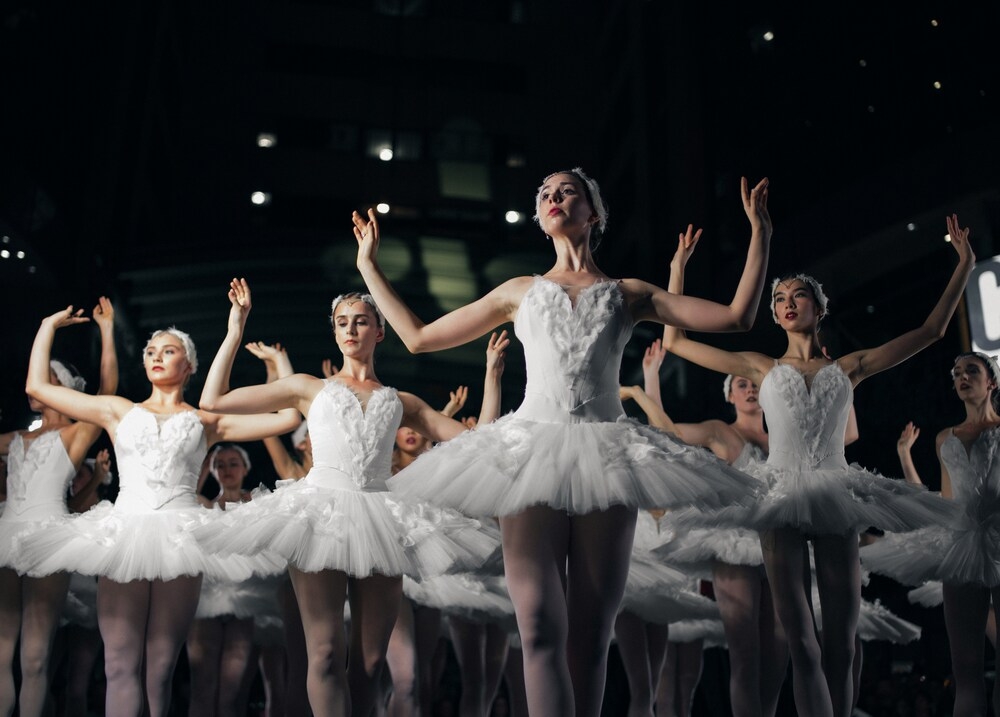Music for ballet classes
Dive into the harmony of ballet and music! Uncover how the perfect tunes can transform your dance. Ready to elevate your ballet class? Let's move to the music!
There's more music!
That's only the tip of the iceberg. We have many more songs, all available with our lifetime licenses:
Why you should purchase from us
Discover the simplest and most cost-effective way to secure a lifetime license – pay once and never worry about account creation or password hassles again! Our licenses are your ticket to the best music, valid for any project, forever.
Get your license now!Use our music on...
Music Plans
Pay once, use for a lifetime
You’ll never have to worry again about copyrights or claims.
Starter
Suited for personal projects and social media (Youtube not included)
$49 / forever
Buy plan- Personal projects
- Social Media
- Clients work
- Online Advertising
- TV, Cinema and Radio
Personal
Most popular
Ideal for Youtube. apps, podcast and gameplays. Unlimited downloads and channels.
$99 / forever
Buy plan- Social Media
- Youtube & Streaming
- Apps & Videogames
- Clients work
- Online Advertising
- TV, Cinema and Radio
Business
Ideal if you're a freelancer or a business. All covered, unlimited downloads and channels
$199 / forever
Buy plan- Any Possible Use Case
- Clients work
- Online Advertising
- TV, Cinema and Radio
👉No need to create an account
👉A lifetime license, forever
👉No more ‘clearing’ channels
We currently offer 241 songs from 30 different genres
Testimonials
Don't take our word for it
“I was skeptical at first but Legis Music has exceeded my expectations. Their music library is diverse and constantly updated, making it easy to find the perfect track for any project. Plus, the peace of mind that comes with that royalty-free license is priceless.”

“@legismusic has made my life as a video editor so much easier. The lifetime license is a no-brainer and the fact that I don’t have to worry about clearing channels or getting copyright strikes is a huge weight off my shoulders. The affordable cost and extensive music library make it the go-to source for all my music needs.”

“As a podcast creator, finding the right music to complement my content can be a challenge, but Legis Music has made it so easy. Their lifetime licenses are affordable and the fact that I can use the music on Spotify and Apple Music is a huge relief. A no-brainer for any podcaster.”

“I was blown away by the value offered by Legis Music's lifetime royalty-free licenses. The cost is incredibly affordable and having the peace of mind to use the music for my clients without worrying about copyright strikes is priceless. I highly recommend this to anyone in need of music for their projects.”

“It was important for me to find a cost-effective solution for my company’s music needs. Legis Music’s business plan was the perfect fit and the lifetime licenses have been a game-changer. We can now use the music for all of our projects without any worries about copyright strikes. Highly recommend to any business in need of music.”

“The quality of the music is top-notch, and the licensing terms are crystal clear, saving me from any copyright hassles.”

“Legis Music has improved the way I create content. The selection of royalty-free music is great and the quality is unbeatable. I can now add the perfect sound to my videos without any stress or added costs. Highly recommended!”

“I've been using Legis Music for my YouTube channel for the past few months, and I couldn't be happier with the service.”

“As a video game creator, having access to high-quality music for my games is crucial. @legismusic lifetime licenses are a steal and the fact that I don’t have to worry about any type of copyrights in the future is a huge relief. The extensive library makes it easy to find the perfect tracks for my games.”

“The audio quality is excellent, and I've never experienced any copyright issues since using their music. The licensing terms are transparent, which is essential for content creators like myself.”

“As a freelance producer, I need to keep costs down and Legis Music has been a huge help for me. The user-friendly platform and affordable pricing make it easy for me to access top-notch music for my clients. Anyone in need of royalty-free music should give it a shot.”

Key Takeaways
- Integral Role of Music: Music in ballet is not merely an accompaniment but a crucial partner in dance, guiding movements, setting the pace, and enhancing emotional expression. It’s foundational to both the learning and performance aspects of ballet.
- Historical Significance: The evolution of ballet music, from its origins to the present, highlights its critical role in shaping ballet as an art form. Key composers like Tchaikovsky and Prokofiev have significantly influenced ballet’s musical and choreographic styles.
- Strategic Selection for Classes: Choosing the right music for ballet classes involves considering the tempo, quality, emotional tone, and variety. This selection is pivotal in matching the music to the class level and the exercises’ objectives.
- Adapting to Different Levels: The complexity of music should align with the dancers’ skill level, from simple, steady rhythms for beginners to complex, emotionally rich pieces for advanced students. This progression supports technical and expressive development.
- Class Structure Integration: Music structures the ballet class from warm-up at the barre to center work and across-the-floor exercises, culminating in cool down and reverence. Each segment benefits from specific musical selections that enhance the intended technical focus and mood.
- Live vs. Recorded Music: Live accompaniment offers unparalleled dynamic responsiveness, while recorded music provides access to a broad repertoire and convenience. Both forms have unique benefits that contribute to the richness of the ballet class experience.
- Enhancing Musicality: Teaching dancers to understand and express the music’s rhythm, timing, and emotional nuances is vital for developing their musicality, a skill as essential as technical proficiency in ballet.
- Innovative Musical Approaches: Incorporating contemporary music and mixing genres in ballet classes can refresh traditional training methods, making ballet more engaging and relevant to modern audiences and dancers.
- Resources Abound: A wealth of resources, including curated playlists, online libraries, and streaming services, is available to assist in finding appropriate music for ballet classes, catering to various levels and styles.
- Evolution and Exploration: The integration of music and ballet is a dynamic, evolving practice that encourages ongoing exploration and adaptation. This ensures the art form remains vibrant and resonant with contemporary audiences and dancers alike.
The enchanting world of ballet is as much a feast for the ears as it is for the eyes.
**At the heart of this classical dance form lies a deep, symbiotic relationship with music. **
This article embarks on an exploration of how music not only complements but also enhances the ballet experience, serving as the very pulse that animates the graceful movements of dancers.
Through a detailed guide, we aim to shed light on the critical role of music in ballet classes, offering insights for instructors, students, and enthusiasts on selecting and utilizing music to its fullest potential.

The role of music in ballet
In ballet, music is far more than a backdrop; it is a partner to the dancer, guiding their steps, framing their emotions, and setting the pace of their performance.
The right piece of music can elevate a routine from a series of movements to a storytelling masterpiece, conveying emotions and narratives without a single spoken word.
In the context of ballet classes, music becomes a tool for teaching rhythm, timing, and expression, essential components of the dancer’s repertoire.
Historical intersection of ballet and music
The union of ballet and music traces back centuries, **evolving together in a dance of mutual influence and inspiration. **
Understanding this historical intertwining is crucial for appreciating the depth of their relationship today.
Evolution of ballet music
Ballet music has journeyed from the court dances of the Renaissance, where it played a secondary role, to the grand, orchestrated works of the Romantic era and beyond, **where it became integral to the ballet’s narrative and mood. **
In the early days, music served primarily to set a tempo for social dances.
By the time of the Ballets Russes in the early 20th century, composers like Igor Stravinsky were crafting scores that challenged both dancers and musicians, weaving complex rhythms and innovative harmonies into the fabric of ballet.
Key composers in ballet history
Several composers have left indelible marks on ballet music.
Pyotr Ilyich Tchaikovsky, for instance, elevated ballet music to a form of high art with his scores for “Swan Lake,” “The Nutcracker,” and “Sleeping Beauty,” blending melody, leitmotif, and orchestration in ways that deeply influenced the development of ballet.
Similarly, Sergei Prokofiev and Leonard Bernstein contributed scores that expanded the emotional and narrative capacities of ballet, showcasing the potential of music to tell a story as vividly as dance.
Through these historical lenses, **we see how ballet and music have grown together, influencing each other’s development. **
This historical backdrop sets the stage for today’s ballet classes, where music continues to play a pivotal role in teaching and performance, echoing centuries of artistic collaboration.
Selecting music for ballet classes
The selection of music for ballet classes is a nuanced process that requires consideration of various factors, including the level of students, the technical or emotional focus of the class, and the overall atmosphere the instructor wishes to create.
Here, we delve into the criteria and considerations for choosing the most appropriate and effective music for ballet instruction.
Criteria for choosing appropriate music
- Tempo and rhythm: The music’s tempo should match the pace of the exercises, with slower tempos for adagios and faster ones for allegros, ensuring that students can follow and internalize the rhythm of the movements.
- Musical quality: High-quality, clear recordings help dancers discern musical nuances, aiding in their musicality and expression.
- Emotional tone: Music that evokes the right emotions can enhance the expressiveness of dancers, connecting their physical movements to deeper feelings.
- Variety: Incorporating a range of musical styles and composers within a class keeps students engaged and exposes them to the broad musical repertoire of ballet.
Musical genres and their uses in ballet
Classical music , with its rich textures and varied tempos,** is traditionally favored in ballet classes for its ability to mirror and enhance the elegance and discipline of ballet techniques.**
However, instructors might also incorporate contemporary music or scores from popular ballets to introduce students to the music they will encounter in performances or to add a modern twist to the class, making it more relatable and engaging for students.
Music for different levels of ballet
As ballet students progress from beginners to advanced levels, the complexity and demands of the music used in their classes also evolve, supporting their technical and expressive development.
Introduction to ballet for beginners
For beginners, music with clear, steady beats and simple rhythms helps in mastering the fundamentals of ballet, such as basic positions and simple steps.
Pieces like Tchaikovsky’s “Dance of the Sugar Plum Fairy” offer recognizable melodies and rhythms that can inspire and engage new dancers.
Intermediate challenges and musical complexity
As students advance, **they encounter more complex music that challenges their timing, coordination, and expressiveness. **
Music with varying tempos and more complex structures, such as selections from Prokofiev’s “Romeo and Juliet,” can aid in developing these skills.
This level may also introduce music with less obvious rhythms, encouraging students to deepen their musicality and ability to interpret music through movement.
Advanced techniques and performance pieces
Advanced students work with a wide range of music that prepares them for the diverse repertoire they will face in performances.
This includes full-length ballet scores, contemporary compositions, and music with challenging rhythms or emotional depth, such as Stravinsky’s “The Rite of Spring.”
Advanced classes may also use music to focus on the interpretive aspects of dance, allowing students to explore and express complex emotions and narratives through their movements.
Selecting the right music for ballet classes at different levels of proficiency not only aids in the technical training of dancers but also nurtures their artistic expression, creating a more enriching and immersive ballet education.
Structuring a ballet class with music
The structure of a ballet class is carefully designed to warm up the body, build technical skills, and then cool down, with music playing a pivotal role at each stage.
Here’s how music intertwines with the class structure:
Warm-Up and barre exercises
The class typically begins at the barre with exercises designed to warm up the body gradually.
Music for these exercises is often steady and moderate in tempo, **allowing dancers to focus on alignment, control, and the precision of their movements. **
Pieces like Bach’s “Cello Suites” offer the measured pace and rhythmic consistency ideal for barre work, helping dancers synchronize their movements with the music.
Center practice
Moving to the center, the class progresses to exercises that develop balance, strength, and technique without the support of the barre.
The music’s tempo can vary, from slow pieces that support adagio movements focused on control and extension, to more lively compositions for jumps and turns.
A piece like Chopin’s “Nocturnes” can provide the lyrical backdrop for adagios, while something with a brisker tempo, like parts of Minkus’ “Don Quixote,” can energize petit allegro sequences.
Across the floor: Allegros and adagios
For traveling movements across the floor, including grand allegros and complex combinations,** music with a dynamic range and dramatic qualities can inspire dancers to expand their movements and expressiveness. **
The grand allegros, in particular, benefit from music that builds momentum, such as the stirring passages found in Tchaikovsky’s ballet scores, encouraging dancers to leap and turn with full commitment and artistry.
Cool down and reverence
To conclude the class, cool-down exercises and reverence allow dancers to stretch, relax muscles, and pay respects to the teacher and pianist.
The music here is often slow and melodic, encouraging a calming and reflective atmosphere.
Debussy’s “Clair de Lune” provides a gentle, soothing end to the rigorous class, helping dancers to wind down.
Live music vs. recorded music
The use of music in ballet classes can vary between live accompaniment and recorded tracks, each with its benefits and considerations.
Benefits of live accompaniment
Live music, typically provided by a pianist, offers a responsive and adaptive musical environment.
A skilled accompanist can adjust the tempo and mood of the music in real-time to match the instructor’s demands and the dancers’ energy, providing a unique and enriching experience that recorded music cannot replicate.
This dynamic interaction between musician, instructor, and dancers fosters a deeper understanding of musicality and its integral role in dance.
Making the most of recorded music
While live music is ideal, the practicalities of budget and availability often mean classes rely on recorded music.
The advantage of recorded tracks is the vast repertoire available, allowing instructors to select precise pieces that fit the technical or emotional focus of the lesson.
To make the most of recorded music, instructors should prepare playlists in advance, considering the structure of the class and the desired outcomes of each segment.
Whether through the adaptive play of live musicians or the strategic selection of recorded pieces, music profoundly shapes the ballet class experience, guiding dancers through a journey of technical mastery and expressive depth.
Musicality in ballet
Musicality in ballet refers to a dancer’s ability to express music through movement, demonstrating an understanding of rhythm, timing, and the emotional nuances of the score.
It’s a critical skill that enhances performance quality, making musicality a central focus in ballet training.
Teaching rhythm and timing to dancers
The foundation of musicality is the ability to match one’s movements with the music’s rhythm and timing.
Instructors often use exercises that require dancers to execute steps on specific beats or within certain musical phrases, training them to listen closely to the music and synchronize their movements accordingly.
For example, simple exercises like tendus or frappés performed to the beat of a metronome or a piano can sharpen a dancer’s timing.
As dancers progress, they can practice more complex combinations that challenge them to maintain their musicality even with intricate footwork or quick changes in tempo.
Expressiveness through musical interpretation
Beyond rhythm and timing, **musicality involves interpreting the music’s emotional and dynamic qualities through dance. **
Instructors might encourage dancers to explore how different qualities of movement can reflect the music’s mood—using smooth, flowing movements for a lyrical adagio piece, or sharp, precise motions for a staccato allegro.
This expressiveness is cultivated by dancing to a wide range of music, from the dramatic swells of a Tchaikovsky ballet score to the subtle nuances of a Chopin nocturne, allowing dancers to experience and express a broad spectrum of musical emotions.
Resources for ballet music
Navigating the vast world of ballet music can be daunting for instructors and students alike.
However, a wealth of resources is available to aid in the discovery, selection, and application of music for ballet classes.
Highlighting these resources can simplify the process, ensuring that every class has a suitable soundtrack that enhances the learning and performance experience.
Recommended playlists and albums
A plethora of albums and playlists specifically curated for ballet classes can be found on music streaming platforms like Spotify , Apple Music , and YouTube.
These collections often categorize music by exercise type (e.g., barre, adagio, jumps) and class level, making it easier for instructors to find appropriate tracks.
Albums by renowned ballet pianists and composers, such as David Howard, Steven Mitchell, and Robert Long, offer a range of music that respects the traditional ballet class structure while providing clear, rhythmic guidance for dancers.
Online libraries and streaming services
Online libraries and streaming services dedicated to ballet and dance music provide an extensive catalog of tracks suitable for various aspects of ballet training.
Websites like BalletMusicDK , DanceClassMusic.com , and BalletClassTunes.com specialize in offering downloadable music and CDs for ballet classes, including both traditional and contemporary pieces.
These resources often feature collections tailored to specific class levels and exercises, from beginner to professional, and may include music for special performances and rehearsals.
Conclusion
The harmonious relationship between music and ballet is foundational, **enriching the dance experience by deepening emotional expression and enhancing technical execution. **
Through the thoughtful selection and application of music, ballet instructors can elevate their classes, fostering an environment where dancers not only refine their techniques but also develop a profound connection to the music they dance to.
This article has traversed the importance of music in ballet classes, from historical insights and selection criteria to innovative approaches and valuable resources.
It underscores the idea that music is not just an accompaniment but a vital component of ballet education, pivotal in cultivating dancers’ musicality and expressiveness.
As ballet continues to evolve, **so too will the ways in which music is integrated into its practice. **
By embracing both traditional and innovative approaches to ballet music, the dance community can ensure that this art form remains vibrant and relevant for generations to come.
Instructors and students are encouraged to explore the wealth of music available, experimenting with different genres and compositions to discover what best enhances their artistic expression and technical growth.
In the end, the fusion of movement and melody in ballet is a testament to the power of these art forms to inspire and transform.
The journey of exploring ballet music is ongoing, promising endless possibilities for those willing to listen, learn, and let the music guide their dance.